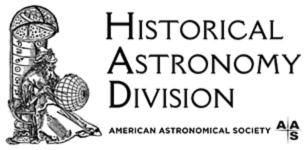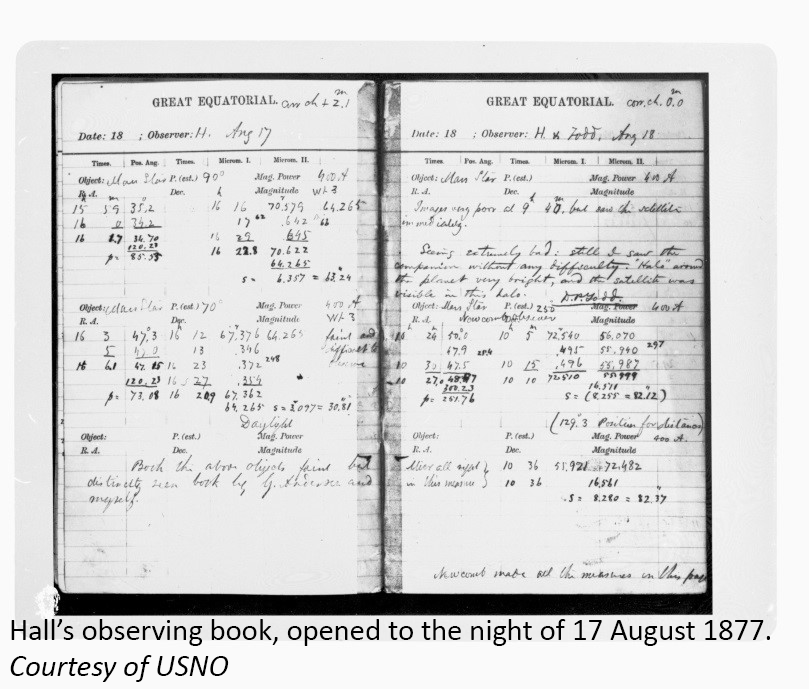This Month in Astronomical History: The Moons of Mars
Teresa Wilson United States Naval Observatory
 Each month as part of this new series from the Historical Astronomy Division of the AAS, an important discovery or memorable event in the history of astronomy will be highlighted. This month, the discovery of Mars's moons is in the spotlight.
Each month as part of this new series from the Historical Astronomy Division of the AAS, an important discovery or memorable event in the history of astronomy will be highlighted. This month, the discovery of Mars's moons is in the spotlight.
 In the scientific realm, the true nature of reality may be described through popular speculation long before the truth can be verified; the discovery of the moons of Mars is one such case. Through the voices of the Laputan astronomers in Gulliver’s Travels (1726), Jonathan Swift announced that Mars had two satellites, giving plausible distances and orbital periods, although he may have added these details to flaunt his understanding of Kepler’s laws rather than from any foreknowledge of the matter. A few years later, perhaps inspired by Swift, the alien visitor in Voltaire’s short story “Micromégas” also mentions Mars’ two moons. Common logic of the time also supposed that since the inner planets had no moons, Earth had one, and Jupiter four, that Mars must have two. Finally, in August of 1877, such speculations changed to reality.
In the scientific realm, the true nature of reality may be described through popular speculation long before the truth can be verified; the discovery of the moons of Mars is one such case. Through the voices of the Laputan astronomers in Gulliver’s Travels (1726), Jonathan Swift announced that Mars had two satellites, giving plausible distances and orbital periods, although he may have added these details to flaunt his understanding of Kepler’s laws rather than from any foreknowledge of the matter. A few years later, perhaps inspired by Swift, the alien visitor in Voltaire’s short story “Micromégas” also mentions Mars’ two moons. Common logic of the time also supposed that since the inner planets had no moons, Earth had one, and Jupiter four, that Mars must have two. Finally, in August of 1877, such speculations changed to reality.
In 1862, Asaph Hall III began work as an assistant astronomer at the US Naval Observatory (USNO) in Washington, DC. Although he was put in charge of the “Great Equatorial” 26-inch refracting telescope, the largest in the world for nearly a decade, shortly after it was installed, he did not turn his attention to Mars until the spring of 1877. After a discouraging search of the literature, Hall decided to leave his fate to the power of the telescope and began a thorough search for satellites in the beginning of August. After ruling out a few distant candidates, he began searching close by, in his own words, "within the glare of light that surrounded it… by keeping the planet just outside the field of view, and turning the eye-piece so as to pass completely around the planet."  His first sighting of the outer moon was made on
His first sighting of the outer moon was made on
Hall named the moons Phobos and Deimos at the suggestion of Henry Madan, Science Master of Eton. Madan was inspired by Book XV of The Iliad in which Ares summons Fear and Flight before descending to Earth to avenge his son. The inner moon, Phobos, proved to be an interesting satellite. Unlike any moons previously discovered, Hall found that its period of revolution is less than 1/3 the period of rotation for the planet. It also orbits only 6,000 kilometers (3,700 miles) above the surface of Mars, closer than any other moons discovered to date. Although the larger of the two moons, these attributes caused Hall to overlook it the night he discovered Deimos, which orbits much farther (around 23,000 km) and much slower (around 30 hours). Recent missions have thoroughly studied many features of the moons, and two of the craters on Deimos, "Swift" and "Voltaire," serve as reminders of the moons’ literary "predictors." However much about them, including their composition and origin, remains a mystery, adding to the never-ending list of unanswered questions about the universe in which we live.

